2019 Annual Report
Principled Leadership in a Challenging World
Communications
Jarrett Stepman
Daily Signal Staff Writer
Follow: Twitter
“The Heritage Foundation continues to rank first among free-market groups in Facebook and Twitter followers. It is also first in web traffic.”
Jarrett Stepman spent his Fourth of July weekend on the road. In Chicago. At a conference of socialists.
“I never thought I’d find myself in a meeting whose theme was ‘No Borders, No Bosses, No Binaries,’” Stepman says. Still, he was glad he went.
A staff writer for The Daily Signal, Heritage’s multimedia news outlet, Stepman shared his stranger-in-a-strange-land experience in “I Went to a Socialism Conference. Here Are My 6 Observations.” Among his takeaways: These folks are dead serious about hard-core socialism; they are adopting open borders as a litmus test; and they are all-in on gender and identity politics.
The eye-opening story garnered 135,000 views on DailySignal.com and was subsequently picked up by The National Interest and Yahoo! News, among other outlets.
Another highlight of Stepman’s year was the publication of his first book, The War on History: The Conspiracy to Rewrite America’s Past (Regnery Gateway, 2019). Unlike socialism, history is right up his alley. With fellow Daily Signal writer Fred Lucas, Stepman has co-hosted Heritage’s “The Right Side of History” podcast for more than two years.
During that time, Stepman has grown increasingly worried that rising generations of Americans lack a decent grounding in civics and American history. “It’s not just that schools no longer inculcate informed patriotism in young Americans,” he explains. “We’re seeing a willful attempt at ‘re-education,’ to reframe our country’s history in ways that turn them against the foundations of America itself.”
Stepman decided to fight back with his pen. Writing the book was “cathartic,” he says, and gave him the opportunity to talk about the problem to big audiences via radio and TV interviews. But what he has enjoyed most is the chance to talk about the book’s themes in smaller groups. “It’s so energizing to meet with conservative activist groups and see them get excited about fighting back when history is under attack in their communities—especially in their classrooms.”
When Stepman wasn’t hanging out with socialists and meeting with conservatives, he managed to write quite a few columns about his native California and how it has lost its way. For example, he wrote feelingly about the state’s new laws granting protections and privileges to illegal immigrants—what he termed “a mockery of democracy and a war on citizenship.”
Another column on the “self-inflicted” energy blackouts that plagued the state during the fall so impressed Fox News that the outlet asked Stepman to write on the subject. His subsequent column explaining why the blackouts were the predictable result of “long-term dysfunctional governance” became that day’s most-read commentary on FoxNews.com.
Protecting Second Amendment Rights
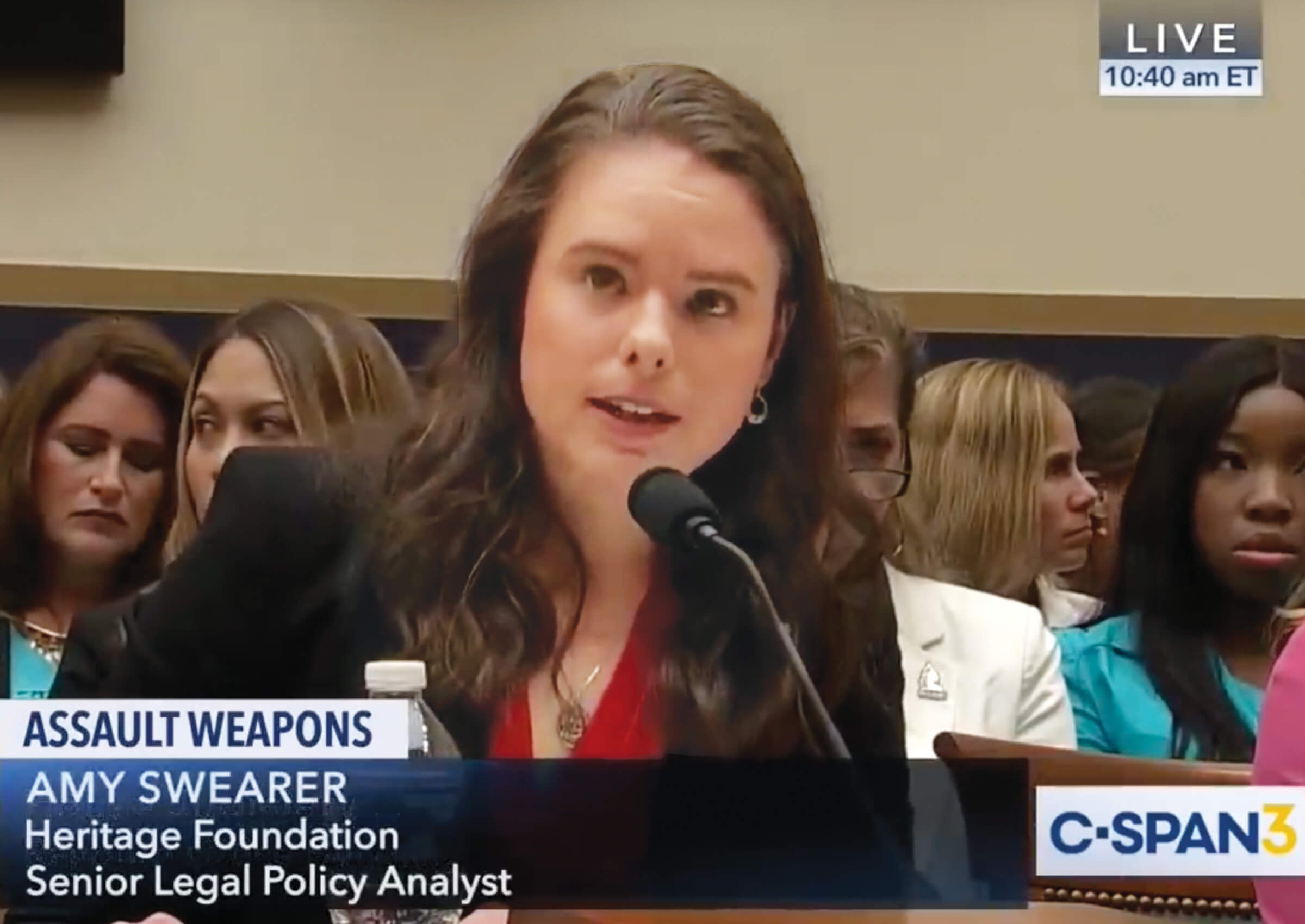
Amy Swearer’s opening testimony before the House Judiciary Committee on firearms. Her video went viral, with over 2 million views on Twitter and more than 1 million on YouTube.
On the World Stage
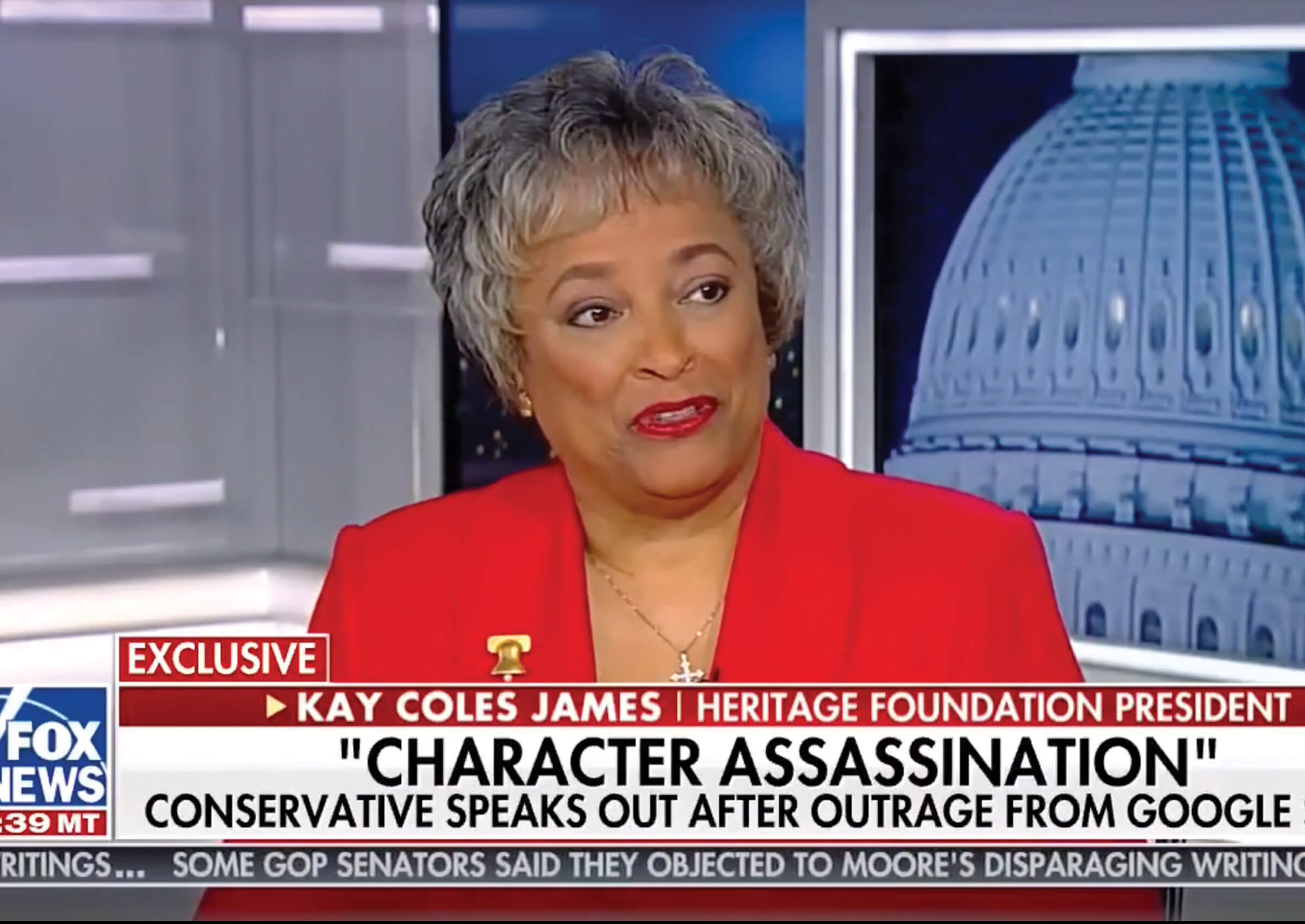
President Kay C. James appeared on “Fox & Friends,” C-SPAN’s “Q&A,” and the BBC’s “World Debate,” reaching a worldwide audience of millions. Washingtonian magazine named her one of its “Top 150 Women of Washington.”
Telling “the rest of the story”
Stepman and his Daily Signal colleagues celebrated two institutional milestones in 2019: the news outlet’s fifth anniversary and its 100 millionth visitor on the web. And throughout the year, they continued to tell important stories—3,300 of them—often covering developments the mainstream media doesn’t want Americans to know about.
Take, for example, the story of Jamie Schupe. Four years ago, Schupe’s transition from male to female was featured in The New York Times. One year later, he decided he was neither male nor female, but nonbinary. When an Oregon judge agreed he could be a third sex, that too, generated massive media coverage.
But in 2019, when Schupe decided to go back to being a man, he found no media interest—until he found a platform at The Daily Signal. His riveting account of his strange odyssey and the damage done along the way became our most-read story of 2019 and led Laura Ingraham to invite him to share his story on her prime-time Fox News show.
Another hugely popular report was a Daily Signal documentary video about Selina Soule, a female high school runner forced to compete against biological males because of Connecticut’s policy on transgender athletes. Our most-watched video ever, it garnered more than 2.8 million views on YouTube and an additional 3.8 million views on Facebook.
Kelsey Bolar’s feature story, based on the same exclusive interview, attracted 429,000 page views on DailySignal.com. Our reporting raised national awareness of the transgender sports issue even as Congress was debating the Equality Act, legislation that could lead to similar challenges for high school girls across the country. The Senate subsequently refused to move the bill forward.
Daily Signal contributors don’t just cover the news, they break it. For example, Nolan Peterson, our longtime foreign correspondent, was one of only six reporters invited to accompany Secretary of State Mike Pompeo on his early August diplomatic swing through Thailand, Australia, and Micronesia.
The following month, Peterson scored an exclusive interview with the secretary during his official trip to Kyiv. Pompeo spoke to him not only about Ukraine and Russia but also about the situation in Afghanistan. A subsequent Washington Post article on the Afghan mission quoted extensively from Peterson’s report.
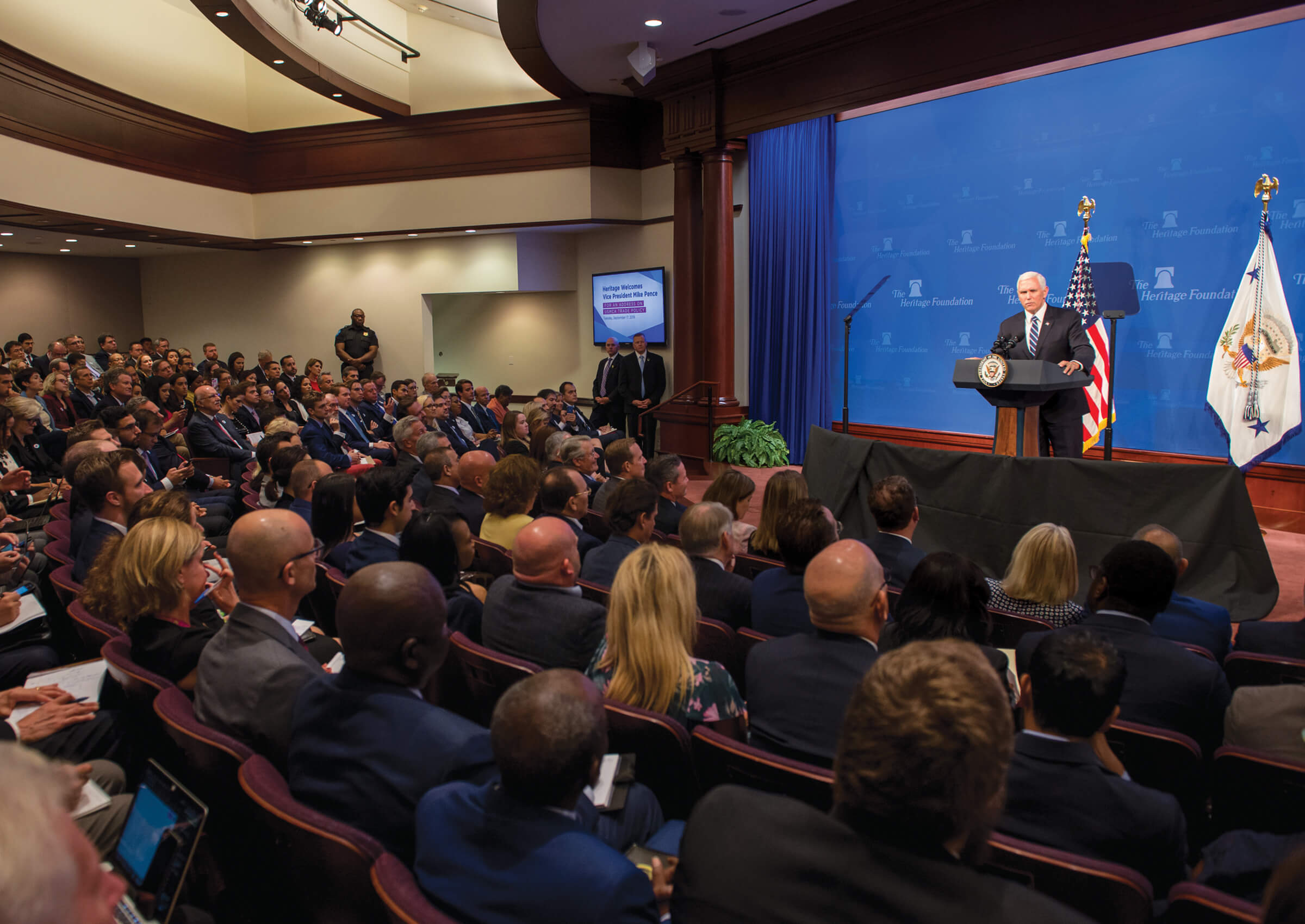
Heritage hosted more than 30 reporters attending Vice President Mike Pence’s September speech on the United States–Mexico–Canada Agreement. The event generated 85 media stories.
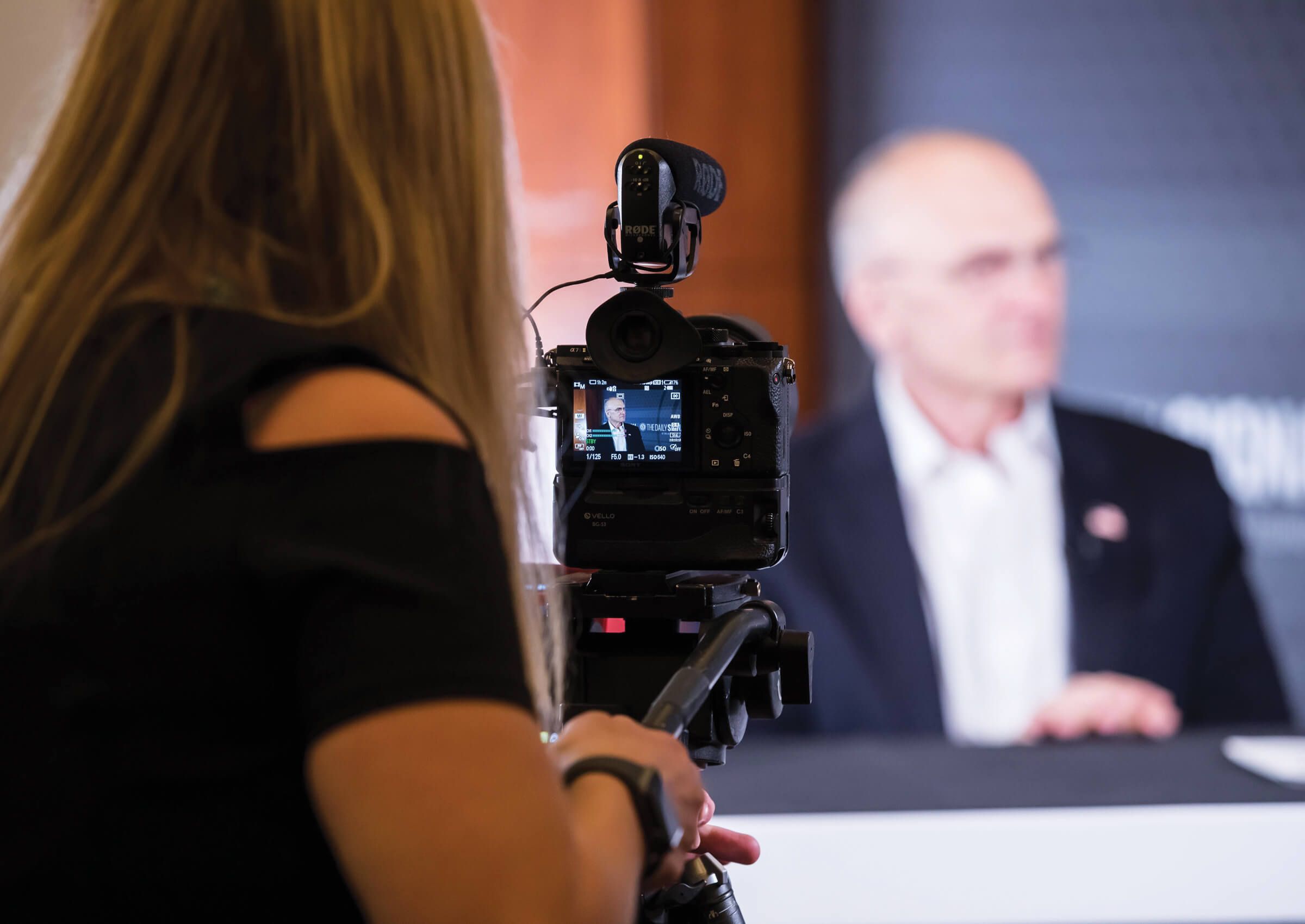
Multimedia Manager Lauren Evans records a Daily Signal interview with former CKE Restaurants CEO Andy Puzder in which he defended capitalism, not socialism, as the economic system best calculated to encourage morality.
Punching Back Twice as Hard
The year was not without excitement for Daily Signal Editor-in-Chief Katrina Trinko. In May, the Poynter Institute for Media Studies put The Daily Signal on its list of unreliable or fake news sites. Trinko responded forcefully with an op-ed that highlighted our perfect rating from NewsGuard (a journalist-run organization that rates news sites for credibility and transparency), the journalism standards we hold to, and Poynter’s failure to meet those standards in its own report.
Poynter quickly climbed down, erasing its bogus list from the internet. “We regret that we failed to ensure that the data was rigorous,” Poynter wrote, “and apologize for the confusion and agitation caused by its publication.”
Another controversy brewed in July when YouTube took down our popular video featuring pediatrician Michelle Cretella on dangerous medical treatments being given to children in “gender transition.” According to the world’s biggest video platform, the interview violated its “hate speech” policy.
Cretella is the executive director of the American College of Pediatricians. What YouTube found to be beyond the pale was her matter-of-fact observation: “See, if you want to cut off a leg or an arm, you’re mentally ill, but if you want to cut off healthy breasts or a penis, you’re transgender.”
Again, Trinko picked up her pen. “Censoring a medical doctor doesn’t put YouTube on the right side of history,” she wrote. “It just shows that it’s a big tech company prioritizing the preferences of the activist left over free speech for all.” We also posted a new YouTube video discussing the censorship. By year’s end, that video had received nearly a quarter-million views.
Meanwhile, other news outlets—Axios, NBC News, The Daily Wire, and more—picked up the story, bringing more heat to bear on the social media giant. An unedited version of the same video on Facebook has now logged more than 3.9 million views.
Still the King of Social Media
Heritage’s digital media operation serves as a role model for think tanks the world around. For the second year in a row, Heritage earned the No. 1 ranking for Best Use of the Internet from the University of Pennsylvania’s Think Tanks and Civil Societies Program.
As the Acton Institute’s Alejandro Chafuen noted in his Forbes column, “Heritage Again Ranks First Among Think Tanks for Social Media Impact”: “Heritage has the most Facebook likes … the most Twitter, Instagram, and LinkedIn followers … [and] the most monthly website visitors.”
Not only is Heritage’s web presence huge, it hits “the right people.” Social media allow us to engage policymakers and young people in a way that meets them wherever they are.
Today, for example, the largest demographic group coming to Heritage.org for information is 25- to 34-year-olds. As for policymakers, a Huffington Post analysis of influential Twitter followers found that Heritage is the No. 1 think tank followed by members of Congress. Only Fox News and President Trump have more followers on Capitol Hill.
Led by Director Maria Sousa, Heritage expanded its digital reach throughout the year. Her team reached a milestone in October when our YouTube channel registered its 100,000th subscriber. The secret to this success: consistently posting new, timely videos. At least, that’s what YouTube Creator Studio cited when honoring us with its coveted Silver Award.
By year’s end, Heritage boasted 2.1 million Facebook fans and 660,000 Twitter followers. Heritage.org and DailySignal.com logged more than 45 million visits during the 12-month period.
Exploding Myths; Winning Millennial Minds

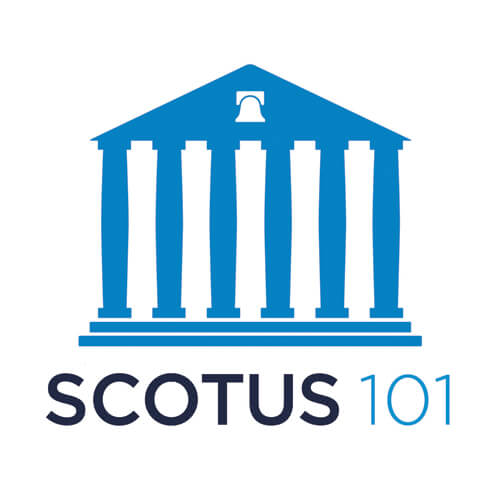
















In the battle to win hearts and minds in the digital space, Heritage has a secret weapon: our interns. Case in point: “Millennial Myths,” a podcast launched in July thanks to intern Samantha Renck.
Working with—and through—traditional media
While the future of media is digital, traditional media remain the primary source of news for most Americans, and Heritage is not about to ignore them.
Our media efforts in shaping the health care debate are a good example of how we engage. In January, our editorial team placed a Bob Moffit op-ed on the pitfalls of Medicare for All with the Tribune News Service. It appeared in well over 30 major newspapers (three of the top 10), as well as six state capital newspapers. The newswire ran two more pieces from the Heritage health expert—one in March, the other in April—each producing the same gratifying results.
Nor was Moffit silent in February—that’s when another national syndicator, Inside Sources, ran another of his exposés of the problems inherent in Medicare for All.
Domestic Policy Studies Director Marie Fishpaw later drove another nail in the Medicare for All coffin, with an op-ed explaining just how much the program would cost typical American families. Her commentary was picked up by more than 50 news outlets, coast to coast.
Heritage messaging on this topic was informed by extensive research conducted by our marketing department. Our messaging was so well thought out and so well received that Media Director Greg Scott was invited to share our research and ideas with the White House. Shortly after Scott’s presentation, President Trump announced that his party would become “the party of health care.”
Just how high was Heritage’s profile on the health reform issue? In November, Business Insider, a publication often not friendly to conservatives, named Fishpaw one of its health care power players. “She’s helped conservatives craft health care reforms with the objective of lowering health care costs and increasing choices,” Business Insider wrote.
Fishpaw was nominated by Senior Communications Manager Marguerite Bowling. This exemplifies how Heritage has reaped recognition and respect by reaching out beyond the warm cocoon of conservative media to reach “gettable” left-leaning media.
That outreach was constant. Media staff coordinated nearly 200 reporter briefings on key policy issues and made countless individual contacts to keep the media abreast of our solutions. It all paid off with a near-constant Heritage presence in traditional media.
Media staff arranged some 1,800 TV interviews and 3,100 radio interviews during the year. Nearly 10,000 print articles cited Heritage experts and research findings.
Heritage experts presented their recommendations in op-eds which appeared in more than 1,800 major print and online news outlets—and even more smaller papers. Their commentaries appeared weekly in daily papers of six capital cities, reaching lawmakers dealing with many of the issues confronting Washington.
Be it local media, national news outlets, or online, Heritage was there, sharing its principled, conservative solutions with all who had eyes to see and ears to hear.
America’s Biggest Issues
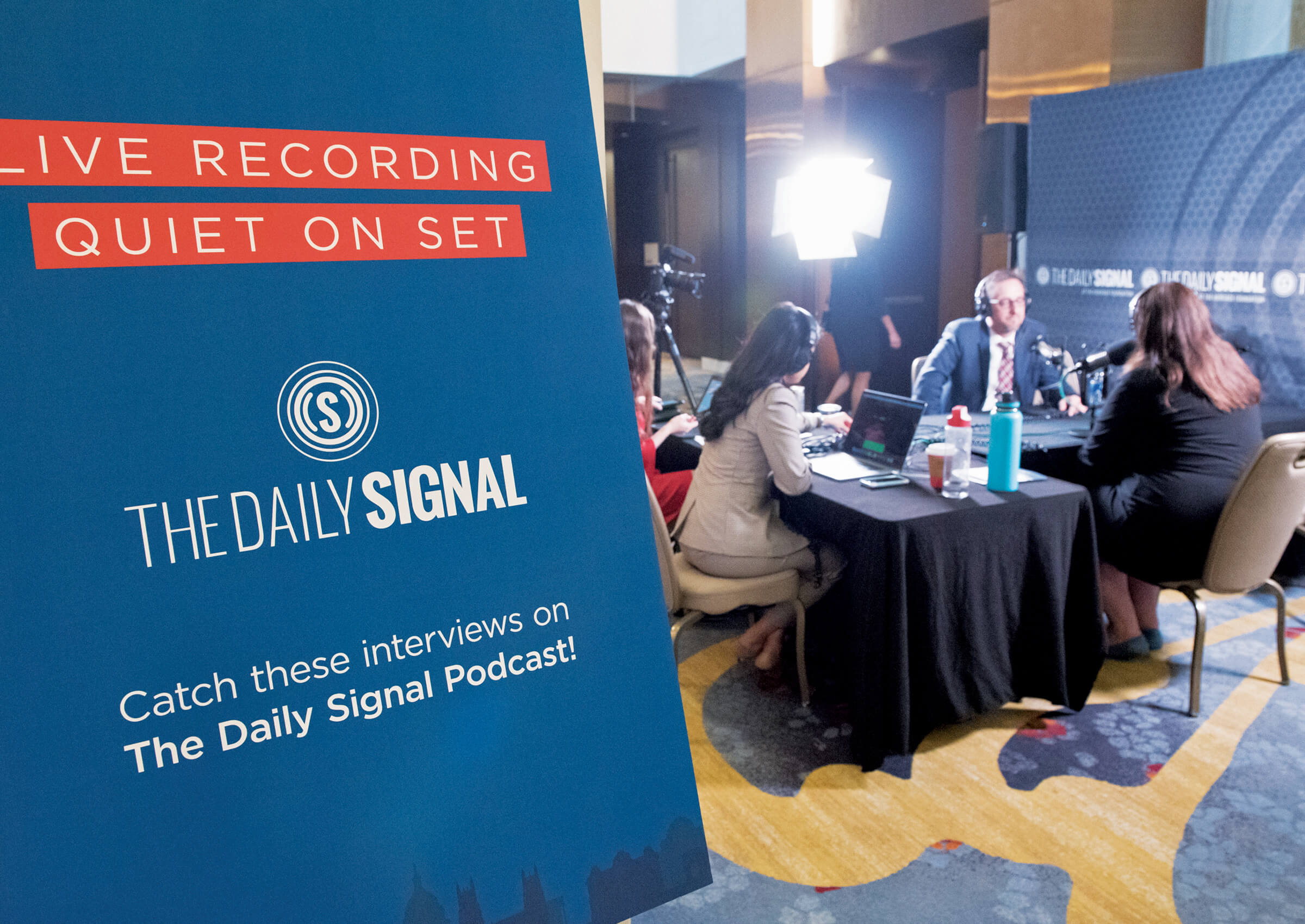

The Daily Signal and multimedia teams work together to record podcasts on the go. At the 2019 President’s Club Meeting, they recorded 10 podcasts right in the middle of all the action.
Health Care, immigration, spending, election integrity—these are just four of the topics covered in “America’s Biggest Issues,” a 10-part video series made possible by a grant from Heritage Premier Associate Tom Lewis.